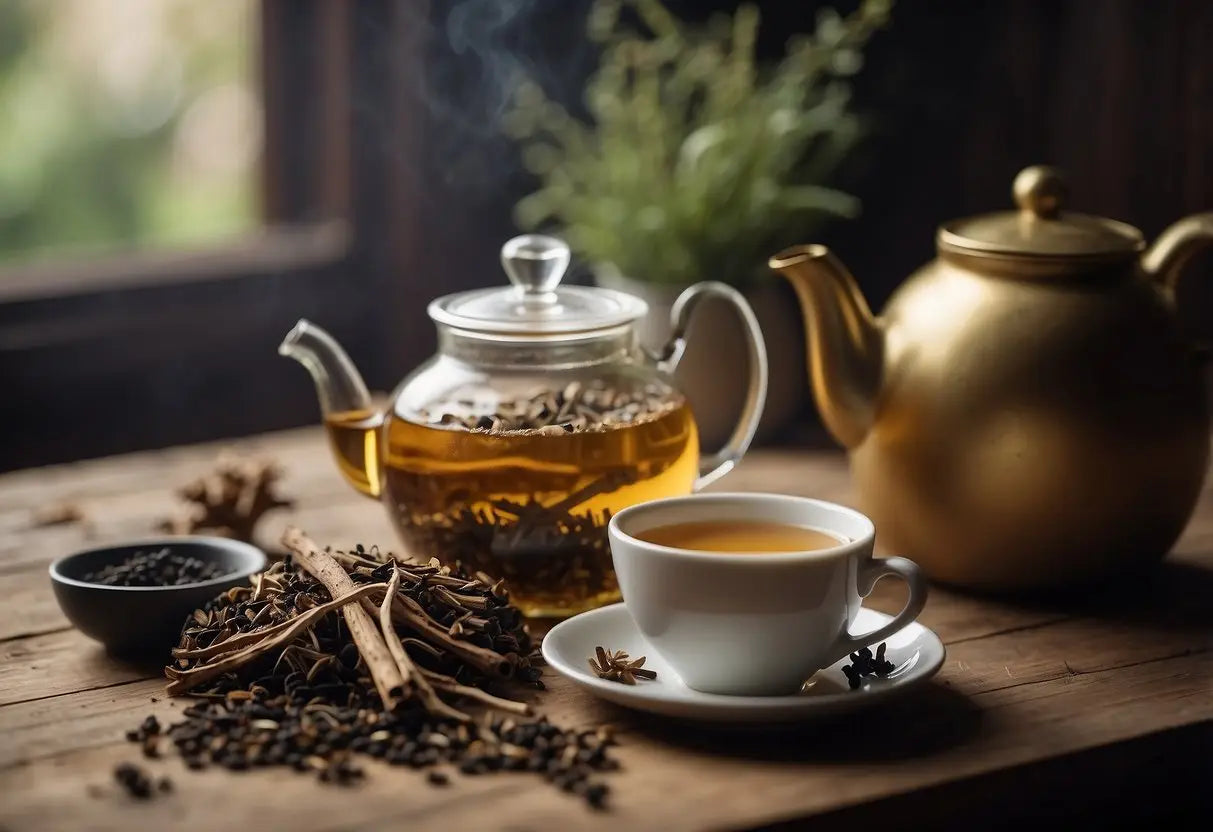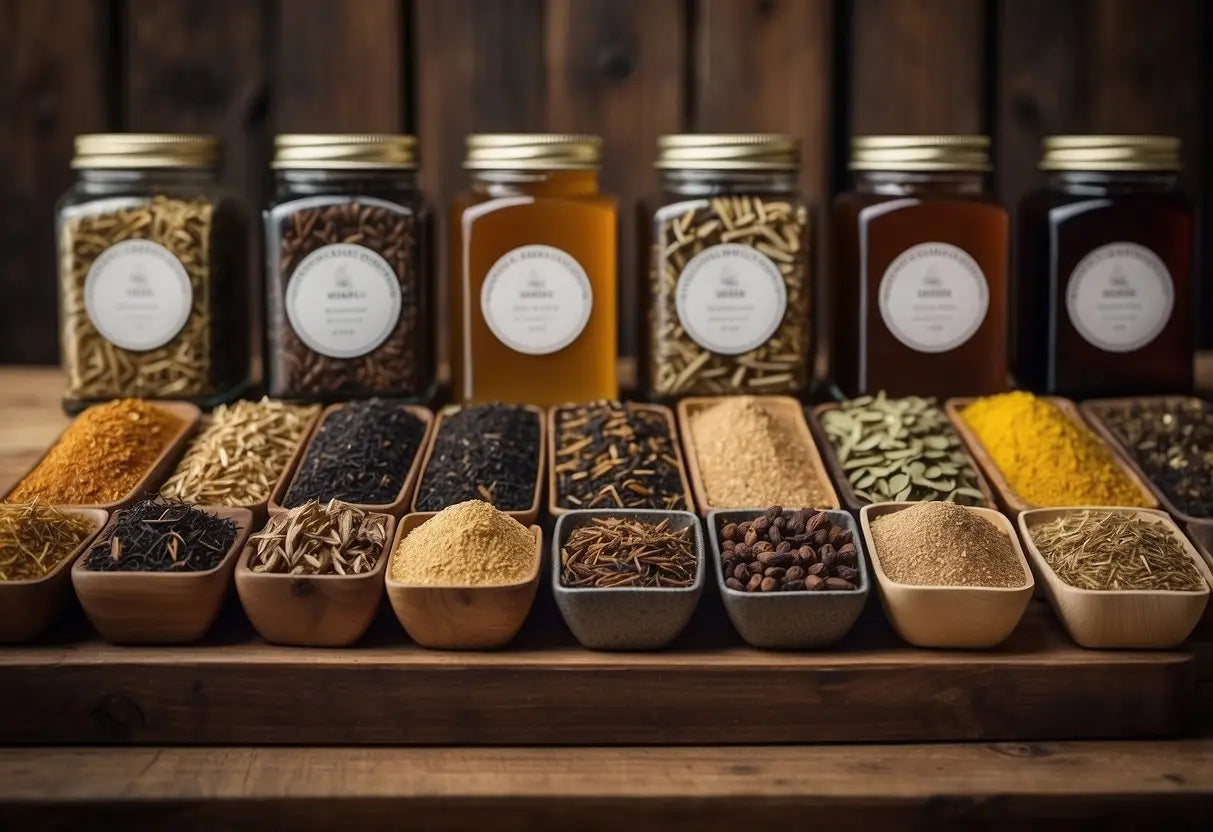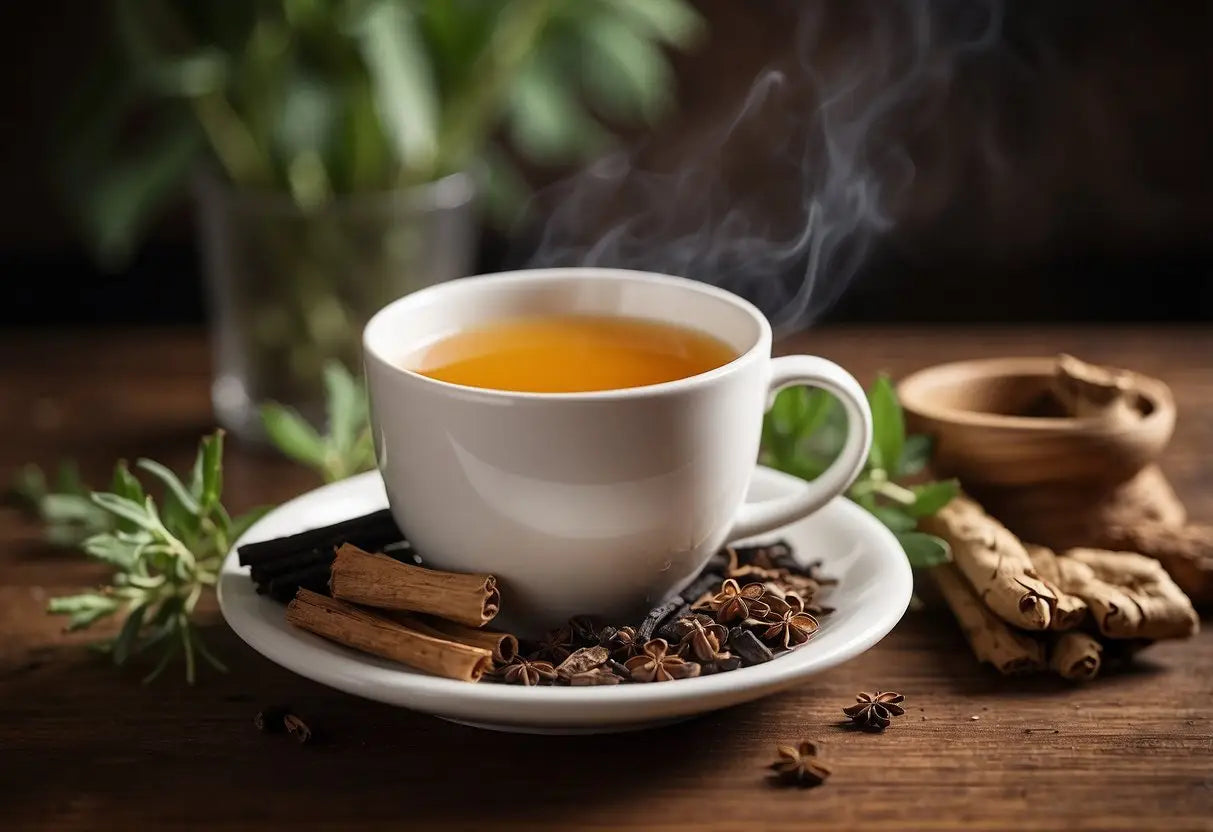Licorice Root Tea
Licorice root tea, made from the root of the licorice plant (Glycyrrhiza glabra), is a popular herbal infusion.
Benefits
- Digestive Health: It may help soothe stomach issues.
- Respiratory Comfort: Often used for its potential to relieve a sore throat and cough.
- Anti-inflammatory Properties: It can reduce inflammation.
Potential Side Effects
- Hypertension: High consumption could raise blood pressure.
- Electrolyte Imbalance: Overuse may lead to decreased potassium levels.
Preparation
- Boil water.
- Add one teaspoon of dried licorice root.
- Steep for 5-10 minutes.
- Strain and enjoy.
Nutritional Information (per 8 oz serving)
| Nutrient | Amount |
|---|---|
| Calories | 0 |
| Carbohydrates | 0 g |
| Sugars | 0 g |
| Fiber | 0 g |
Precautions
- Pregnancy: Not recommended due to potential risks.
- Medical Conditions: Consult your doctor if you have heart or kidney issues.
Enjoy licorice root tea in moderation to benefit from its properties.
Historical Use

Bestsellers
Licorice root tea has a long history in traditional medicine and holds significant cultural importance in various societies.
Traditional Medicine
Licorice root has been used in traditional medicine for thousands of years. In ancient Egypt, it was included in various remedies and even found in the tomb of Pharaohs. Traditional Chinese Medicine (TCM) also features licorice root prominently. It is known as Gan Cao and is believed to harmonize the effects of different herbs in a formula.
In Ayurvedic medicine, licorice is used for its demulcent properties, which help to soothe inflamed tissues. It has applications in treating conditions like respiratory issues, digestive disorders, and skin ailments. Ancient Greek and Roman texts also reference licorice root for its medicinal qualities, particularly for its benefits in treating coughs and colds.
Cultural Significance
Licorice root tea's cultural significance extends beyond its medicinal uses. In some Middle Eastern cultures, it is enjoyed during social gatherings and Ramadan, symbolizing hospitality and celebration. The sweet taste made it a popular choice for beverages and confections.
In Japan, licorice is an ingredient in traditional Kampo medicine and remains in use today in modern variants. The tea is a staple in several regions, valued both for its flavor and its health benefits. Its enduring presence in cultural rituals highlights its deep-rooted history and importance across different societies.
Health Benefits
Licorice root tea offers various health benefits. It supports digestive health, improves respiratory function, and has stress-relieving properties.
Digestive Support
Licorice root tea can soothe digestive discomfort. It contains compounds like glycyrrhizin, which help reduce inflammation in the stomach lining. This can alleviate symptoms of indigestion, bloating, and heartburn.
You may find it particularly useful for conditions like acid reflux or gastritis. It can also promote a healthy balance of bacteria in your gut.
For those dealing with stomach ulcers, licorice root tea can act as a protective agent. It forms a mucus layer preventing stomach acids from irritating the ulcer site.
Respiratory Health
Licorice root tea is beneficial for respiratory health. It acts as a natural expectorant, helping you to clear mucus from your airways. This makes it easier to breathe, particularly during colds or seasonal allergies.
The anti-inflammatory properties of licorice root can reduce irritation in your throat and lungs. It also contains antimicrobial agents that may help fight respiratory infections.
People suffering from chronic conditions like asthma or bronchitis may find relief by incorporating this tea into their routine. It can soothe sore throats and reduce coughing spells.
Lao Ban Zhang
Stress Relief
Licorice root tea can also help manage stress. It has adaptogenic properties, which means it helps your body cope with stress more effectively. Drinking this tea can stabilize your cortisol levels, reducing overall stress and fatigue.
It may also improve mental clarity and energy levels, making it easier for you to focus on daily tasks. The tea supports adrenal gland function, which is crucial for your body's stress response.
Incorporating licorice root tea into your routine can promote a sense of calm and well-being. This can be particularly beneficial during periods of high stress or anxiety.
Nutritional Profile

Licorice root tea offers several nutritional benefits. It's known for its range of vitamins and minerals that support various bodily functions.
Key Nutrients:
- Vitamin B1 (Thiamine)
- Vitamin B5 (Pantothenic Acid)
- Vitamin E
These vitamins contribute to energy production and cellular health.
Minerals Present:
- Calcium
- Iron
- Potassium
- Magnesium
These minerals play a role in maintaining bone health, red blood cells, and electrolyte balance.
Antioxidant compounds found in licorice root tea can protect your cells from oxidative stress. Notably, it contains:
- Flavonoids
- Phenolic Acids
These compounds support your body's defense mechanisms against free radicals.
Licorice root tea also contains some carbohydrates which can offer a mild energy boost. The tea is low in calories, making it a healthy addition to your diet.
Caution: Be mindful of glycyrrhizin in licorice root, a compound that can affect blood pressure if consumed in large quantities. Moderation is key.
Preparation and Brewing Methods

To prepare licorice root tea, you will need dried licorice root, water, and a pot or kettle.
Ingredients:
- 1 teaspoon of dried licorice root
- 1 cup of water
Steps:
- Measure the Ingredients: Measure 1 teaspoon of dried licorice root.
- Boil Water: Bring 1 cup of water to a rolling boil.
- Combine: Add the dried licorice root to the boiling water.
- Simmer: Reduce the heat and let it simmer for 10 minutes.
- Strain: Pour the tea through a fine mesh strainer.
- Serve: Pour the tea into a cup and enjoy.
Experiment with steeping time to adjust the flavor. Always store dried licorice root in an airtight container to maintain freshness.
Side Effects and Precautions
Licorice root tea has various health benefits but also poses certain risks. It's essential to be mindful of appropriate dosages, potential interactions with medications, and possible adverse effects.
Recommended Dosages
For general health, 250-500 mg of powdered licorice root per day is commonly recommended. Consuming more than this can lead to health issues. It's often advised to limit intake to no more than two weeks without consulting a healthcare provider. Pregnant women should avoid licorice root tea due to potential risks to the fetus. Always start with a small amount to gauge your body's response.
Potential Interactions
Licorice root tea may interact with various medications, including blood pressure drugs and diuretics. It can enhance the effects of corticosteroids, leading to an increased risk of side effects. Those on medications for heart conditions should consult a doctor as licorice can cause irregular heartbeats. Mixing licorice with contraceptive pills or hormone therapy might alter hormone levels.
Adverse Effects
Excessive consumption of licorice root tea can cause hypertension, edema, and potassium depletion. These issues can lead to serious conditions like heart problems. Symptoms of adverse effects include headaches, fatigue, and shortness of breath. Individuals with kidney issues should avoid it, as it can worsen their condition. Always report any unusual symptoms to your doctor immediately.
Varieties of Licorice Tea

Licorice tea comes in a variety of forms, from pure licorice to blends with other herbs and flavors. Each type offers unique benefits and characteristics.
Pure Licorice Tea
Pure licorice tea is made from the root of the licorice plant and has a distinctive sweet flavor due to glycyrrhizin, its main active compound. This tea is often revered for its potential health benefits, such as soothing digestive issues and supporting respiratory health.
You will notice a naturally sweet and somewhat strong taste. Pure licorice tea can also be quite intense, making it a favorite for those who enjoy robust flavors. It's important to consume in moderation due to the potency of its active ingredients, which can cause side effects in high doses.
Licorice Blend Teas
Licorice blend teas combine licorice root with other herbs and ingredients, creating a more nuanced flavor profile. Common ingredients mixed with licorice include peppermint, ginger, and chamomile, each bringing its own health benefits.
These blends provide a balance, making the tea milder and more palatable for those who find pure licorice tea too strong. Blended teas can offer a variety of therapeutic effects, from calming the mind to aiding digestion. For example, a blend with chamomile can be particularly soothing before bedtime.
Different brands and blends will vary, so it's worth trying a few to find your preferred combination.
Consumer Considerations
When purchasing licorice root tea, it’s crucial to consider whether to choose organic or non-organic options and the importance of sustainable sourcing practices.
Organic vs Non-Organic
Licorice root tea can be found in both organic and non-organic varieties. Organic licorice root tea is grown without synthetic pesticides or fertilizers, making it a preferable choice if you’re concerned about chemical residues.
Non-organic options may be more readily available and sometimes less expensive, but they could potentially carry traces of agricultural chemicals.
Choosing organic might also support better farming practices that maintain soil health and reduce environmental pollution. Consider the certification of the product, such as USDA Organic, to ensure you’re getting a genuine organic product.
Think about your priorities regarding pesticide exposure and environmental impact when making your choice.
Sourcing and Sustainability
Consider where and how the licorice root is sourced. Sustainable sourcing ensures that licorice root is harvested in a way that doesn't deplete natural resources or harm local ecosystems.
Look for teas that are labeled Fair Trade or have similar certifications, as these often guarantee fair wages and good working conditions for farmers.
Brands that engage in sustainable sourcing often provide information on their packaging or website about their practices. This might include details on how they protect biodiversity and ensure ethical labor conditions.
Your choices can support good environmental and social practices in the production of licorice root tea.
Taste Profile

Licorice root tea offers a distinctive, naturally sweet flavor. The sweetness is often described as both mellow and rich.
When you take a sip, you might notice a subtle hint of earthiness. This adds depth to the overall taste, balancing the sweetness.
A faint peppermint-like note can be detected, adding a refreshing touch.
Flavor Characteristics:
- Sweetness: Naturally sweet, rich
- Earthiness: Subtle, grounding
- Minty Note: Slightly refreshing
This combination creates a unique and pleasant experience. The sweetness is not overpowering, making it enjoyable.
Interesting Fact: This tea doesn't require additional sweeteners due to its inherent sweetness.
Enjoy licorice root tea hot or cold.
Storage and Shelf Life
To maintain the freshness and potency of licorice root tea, store it in a cool, dry place.
Keep it away from direct sunlight and strong odors. Airtight containers are ideal to prevent moisture and preserve the tea’s aroma and flavor.
Optimal Storage Conditions:
- Temperature: Below 77°F (25°C)
- Humidity: Low, around 30-50%
- Light: Dark or opaque containers to block light exposure
Packaging Options:
- Glass jars: Ensure they are tinted or kept in the dark.
- Metal tins: These provide an excellent barrier against moisture and light.
- Plastic containers: Use BPA-free plastic for safe storage.
To ensure the best quality, label your storage containers with the purchase date.
Licorice root tea typically has a shelf life of 1-2 years when stored properly.
Whole roots may last longer than pre-cut or ground varieties.
Regularly check for signs of spoilage, such as unusual odors or off flavors. If detected, it’s time to discard and replace.
Proper storage ensures that your licorice root tea remains fresh and enjoyable for much longer.
← Older post Newer post →











